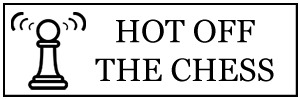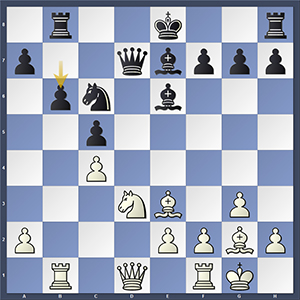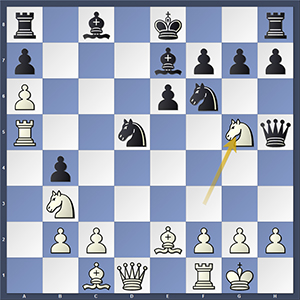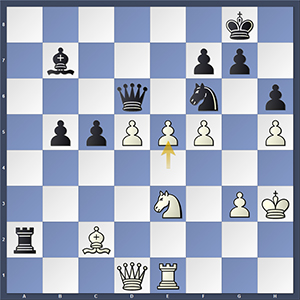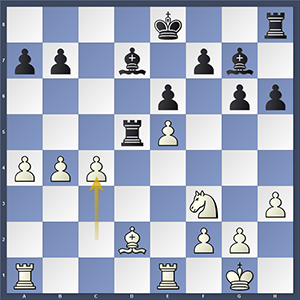
Round six of the Tradewise Gibraltar Masters 2017, saw the leaders cut in half (from six to three) as some had a bad day and some a very good one.
Having a good day, was defending Champion, Hikaru Nakamura, who faced fellow leader, Maxime Lagarde. Nakamura obtained an egde in the Symmetrical English, but it was really his opponent leaving his King in the centre of the board that really led to Hikaru getting the bit between his teeth. 13…Qd7 should probably have given way to …0-0, and then, 14…b6 just did not do enough to back up c5. This s shown in the diagram, below.
Nakamura continued 15.Nxc5! The issue, here, is that Black has not one but three misplaced pieces, the Queen on d7, the un-castled King and the rook on b8. This means that the b-pawn is in effect frozen in place due to Bxc6 Qxc6, Rxb8, completely winning. Black took the most respectable route, which was 15…Bxc5 16.Bxc5 Qxd1 17.Rfxd1 bxc5 18.Bxc6+ Ke7. This left White a pawn up, but the position had yet to be proven, especially with both having light-squared bishops. Not straight forward by any means!
And indeed, Nakamura found it no easy task in proving that he held the upper hand, Lagarde was holding things quite well until his mistake 28…Rc7(? …c4 was fine for Black). This allowed Nakamura’s 29.Ra5(!), pinning the weak c-pawn, which fell on the next move. White was suddenly winning and Hikaru made no mistake from here and Lagarde was resigning just a few moves later.
I am not sure what Michael Adams was on during his game against Ju Wenjun, but whatever it was, I’d like a bit of it. The English Grandmaster gave his opponent a bit of a lesson, it has to be said. Playing White in a Tarrasch French Defence, Adams was on absolute fire. His 9.a4 and 10.a5 were early signs of aggression and this pawn would go all the way to a6.
Meanwhile, Ju was exposing her Queen, which became more and more targeted as White became more active. The diagram, below, shows the absolute dire situation that Black had gotten herself into, with her Queen surviving by the skin of her teeth.
Never-the-less, Adams was completely winning and showed that he is still very much a force to be reckoned with, launching a very co-ordinated and powerful attack. Black was given absolutely no chance to recover her situation and to be honest, the game was a bit of a butchering. In the end, Ju was getting mated and resigned, but her game was technically over much sooner.
After a couple of wins with White, we now turn our attention to a win with Black. In another battle of leaders, Emil Sutovsky took on David Anton Guijarro in a closed Ruy Lopez. Black managed to equalise comfortably in the game and after a couple of inappropriate moves by White (24.f5, for example, which was a little out of context), ended up better.
It is possible that Sutovsky realised that things had not worked out and felt some frustration and/or anxiety, as he then began to over-push. Black took this in his stride and slipped behind the White lines.
After 34.e5(? this move is actually inappropriate as White is defending and not in a position to make such bold moves) …Qxe5 35.d6, Anton Guijarro confidently exchanged his remaining rook for White’s bishop and was winning. The passed pawn on the d-file was merely a pretender and was dealt with by Black without problems. After this, Sutovsky had nothing and in the end was left with only King and rook with which to fight King, bishop and 4 pawns, two of which were beautifully connected. These began to advance down the board and it was game over.
These results meant that the top of the table was cut from six players to three, as Adams, Nakamura and Anton Guijarro slayed their competition to share the lead. There is, however, one more result that we should look at, that happened a little further down the table, as Nigel Short took on World #2, Fabiano Caruana.
Short played White in the Caro-Kann Two Knights, and completely dominated and outplayed his opponent, it must be said. Making good, logical moves, he developed swiftly in a way that is extremely instructive to those who wish to learn how to open a game effectively. There was not an immense amount of theory in this game, it was a case of using each and every move wisely and with effect.
White achieved this much better than Black, and this resulted in Short carrying a good initiative into the middlegame. And he wasted no time in using it, which is again instructive. Black had the bishop pair, but they were for a time mere spectators and this gave White a complete free hand, his a and b-pawns advancing up the board, soon to be joined by the c-pawn.
The game was in effect, strategically won very speedily, all that was left was to convert the advantage. Nigel did this without too much problem, using his pieces to make life extremely unpleasant for Fabiano in trying to defend. Queening a pawn claimed a rook and Black was left with a bishop and four pawns against White’s rook and three pawns. It was no match, especially as Short’s activity absolutely trumped Caruana’s. By hook or by crook, White was going to add another Queen, it was more a question of how rather than if, and Black resigned.
A really nice game from Nigel Short, one to be studied rather than viewed.
